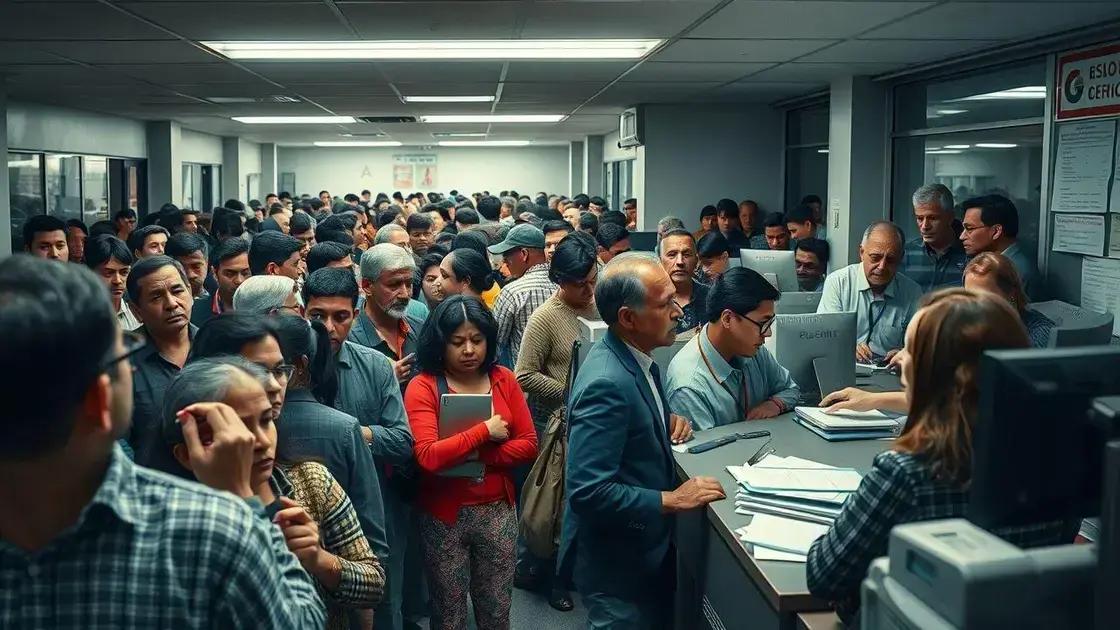Government agency staff insufficiencies forecast: What to expect

The forecast for government agency staff insufficiencies indicates critical challenges in public service delivery, driven by economic factors, workplace culture, and a need for improved recruitment and technology adoption.
Government agency staff insufficiencies forecast suggest significant challenges ahead for public sector operations. Are you aware of the potential implications for service delivery? Let’s dive into the details.
Current trends in government staffing deficits
Understanding current trends in government staffing deficits is crucial for addressing operational challenges. Many agencies are facing significant shortages, which can hinder their ability to serve the public effectively. Let’s explore some key factors contributing to these deficits.
Factors contributing to staffing shortages
The reasons for these deficits can vary widely. Economic conditions, changing workforce demographics, and competitive job markets all play a role. Additionally, the pandemic has accelerated certain trends, such as early retirements and a shift in priorities among workers.
- Economic downturns can lead to budget cuts.
- Competition with the private sector makes it hard to attract talent.
- Increased workloads often result in employee burnout.
- Retirements in large numbers leave gaps that are hard to fill.
As agencies struggle to attract new talent, many are enhancing their recruitment strategies. This may include offering flexible work arrangements, competitive salaries, and comprehensive benefits packages. Some agencies even focus on improving workplace culture to retain their existing employees.
The impact of technology
Technology also shifts how agencies approach staffing. Automation and digital tools can help manage workloads but may not fully replace human roles. Embracing technology can lead to more efficient operations, allowing remaining staff to focus on critical tasks.
Nevertheless, it’s essential to balance technology with the human touch that government services often require. Without sufficient staff, these valuable services risk becoming impersonal and ineffective.
In summary, the current trends in government staffing deficits present significant challenges. To address these issues, agencies must adapt by refining recruitment strategies and embracing technology while focusing on retaining their current workforce. Taking these steps could help alleviate staffing shortages and ensure better service delivery.
Reasons behind staff shortages in agencies
Understanding the reasons behind staff shortages in agencies is essential for developing effective solutions. These shortages arise from a combination of various factors that impact hiring and retention in the public sector.
Economic Factors
Economic conditions significantly influence staffing levels. Budget constraints can lead agencies to limit hiring or reduce salaries, making them less competitive compared to private sector jobs. During economic downturns, agencies might face layoffs, leading to a reduced workforce that can be challenging to rebuild.
- Budget cuts restrict hiring opportunities.
- Market competition for skilled workers increases.
- Economic instability leads to uncertainty in employment.
Additionally, the demands on government agencies often increase during economic hardships. This creates a paradox where fewer staff are needed to accomplish more, leading to higher levels of stress and job dissatisfaction.
Workplace Culture and Environment
The workplace culture plays a key role in whether employees stay or leave. A positive culture fosters job satisfaction, while a negative environment does the opposite. Agencies lacking recognition and growth opportunities often see high turnover rates. When employees feel undervalued, they may seek other employment options.
Moreover, the stresses associated with public service can lead to burnout. When workers are continuously expected to do more with less, their motivation and productivity can decline. This creates a cycle of increasing shortages as remaining staff may leave due to exhaustion.
The demographics of the workforce are also shifting. As older employees retire, there is a gap that younger generations have not filled as readily, often preferring jobs that offer flexibility and work-life balance. Agencies that can adapt to these preferences may find better success in retaining talent.
Ultimately, understanding the reasons behind staff shortages in agencies involves analyzing economic factors, workplace culture, and changing demographics. Addressing these issues directly can help promote a healthier workforce and better service delivery.
Impact of insufficiencies on public services

The impact of insufficiencies on public services can be profound and often creates a ripple effect through communities. When agencies lack sufficient staff, the quality of services declines, leading to frustrations for both employees and the public.
Service Delays and Inaccessibility
One major consequence of insufficient staffing is delayed services. When there aren’t enough employees to handle workloads, tasks that should be completed promptly can take much longer. This can lead to long wait times for citizens seeking assistance.
- Increased wait times for public assistance.
- Compromised services due to prioritization of urgent needs.
- Lack of accessibility for important services.
Furthermore, some services may become completely inaccessible if staffing shortages reach critical levels. Citizens may feel abandoned or ignored, causing distrust in government agencies.
Quality of Service
When staff members are stretched thin, their ability to provide quality service diminishes. Overworked employees are more likely to experience burnout, which can lead to mistakes and inconsistencies in service delivery. This can frustrate the very people agencies aim to help.
Additionally, the focus shifts from maintaining high-quality standards to merely getting tasks done. This degradation in service quality affects public satisfaction and can tarnish the reputation of government agencies.
Ultimately, the impact of insufficiencies on public services is significant. The resulting delays, decreased quality, and public dissatisfaction can hinder the effectiveness of government operations. Addressing these insufficiencies is crucial for restoring public trust and ensuring that agencies can fulfill their obligations.
Strategies for mitigating staffing challenges
Addressing staffing challenges in government agencies requires effective strategies for mitigating these issues. A proactive approach can help improve recruitment and retention, ensuring that public services remain efficient and effective.
Enhancing Recruitment Efforts
Improving recruitment is essential to filling vacant positions. Agencies should consider broadening their recruitment efforts to attract a diverse pool of candidates. Utilizing modern platforms like social media and online job fairs can reach potential employees who may not have considered public service before.
- Use social media for job postings.
- Attend job fairs to engage with candidates.
- Offer internships to spark interest in public service careers.
In addition to traditional methods, enhancing the agency’s visibility and attractiveness as an employer can be beneficial. Promoting success stories and the positive impact of agency work can intrigue candidates seeking meaningful careers.
Improving Work Culture and Employee Support
A supportive work culture can significantly boost employee retention. Agencies should prioritize employee wellness programs, mentorship opportunities, and professional development. When employees feel valued and supported, they are less likely to leave their jobs.
By creating an environment that fosters collaboration and respect, agencies can improve morale and productivity. This environment also helps attract new employees who see the organization as a place where they can grow.
Furthermore, offering flexible work arrangements, such as remote work options, can make agencies more appealing to potential candidates. Many workers today prioritize work-life balance, so adapting to these preferences can help agencies stand out.
Implementing these strategies for mitigating staffing challenges can lead to improved staffing levels and better service delivery. Active engagement in recruitment and retention efforts can create a more sustainable workforce for the future.
Future outlook for government workforce planning
The future outlook for government workforce planning is shaped by various trends and changes in both society and technology. As agencies prepare for upcoming challenges, strategic planning is essential for creating effective workforces.
Emphasis on Data-Driven Decision Making
Data analysis is becoming crucial in workforce planning. By utilizing data, agencies can predict staffing needs based on current trends, retirements, and projected service demand. This proactive approach ensures that agencies can adapt promptly to changing circumstances.
- Utilize analytics to understand workforce demographics.
- Forecast staffing needs using historical data.
- Implement feedback systems to improve planning accuracy.
Accessing accurate data can help leaders make informed decisions about where to allocate resources and prioritize recruitment efforts.
Adoption of New Technologies
Technology will play an increasingly important role in the future of government workforce planning. Automation and artificial intelligence (AI) can streamline hiring processes, improve employee management, and enhance overall productivity.
These tools can also help identify skills gaps within the workforce, guiding agencies to invest in training and development to better prepare their teams for future challenges.
Furthermore, remote work will likely continue to be a significant factor in workforce planning. Agencies must adapt to attracting talent who prioritize flexibility and work-life balance. Offering remote work options can help widen the talent pool and improve employee satisfaction.
Finally, collaboration and partnerships with educational institutions can facilitate a better alignment between workforce needs and training programs. By working together, agencies can create pipelines of skilled workers ready to meet public service demands.
In summary, careful consideration of these elements will help shape the future outlook for government workforce planning. By embracing data-driven decision-making, adopting new technologies, and fostering partnerships, agencies can build a more resilient workforce.
FAQ – Frequently Asked Questions about Government Agency Staff Insufficiencies
What are the main causes of staffing shortages in government agencies?
Staffing shortages can arise from budget cuts, competition with the private sector, employee burnout, and a lack of effective recruitment strategies.
How can agencies improve their recruitment efforts?
Agencies can enhance recruitment by utilizing social media, attending job fairs, and creating internship programs to attract a diverse candidate pool.
What role does workplace culture play in employee retention?
A positive workplace culture fosters job satisfaction and can significantly reduce turnover by making employees feel valued and supported.
How can technology help address staffing challenges?
Technology, like data analytics and automation, can streamline hiring processes, identify skills gaps, and improve overall workforce management.






